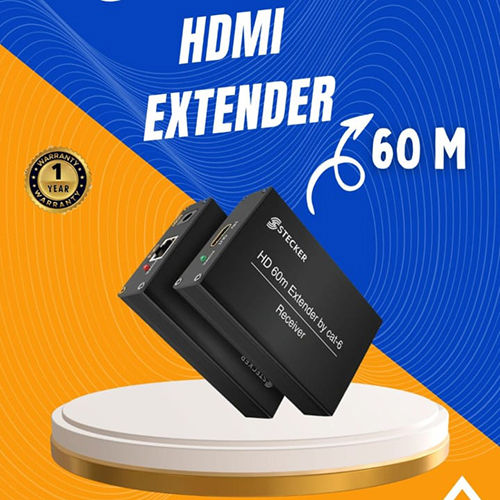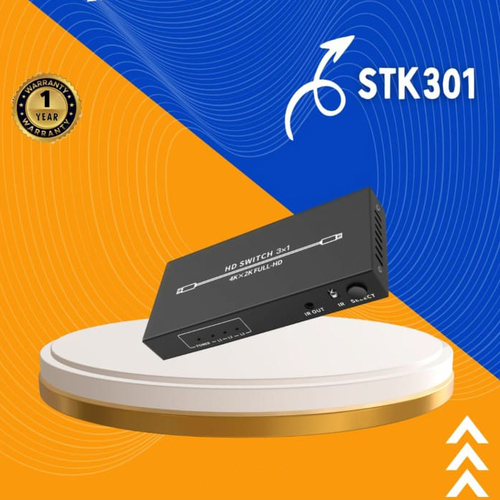HDMI Extender Overview
Product Details:
- Product Type HDMI Extender Overview
- Application Industrial
- Jacket Color Black
- Warranty 1 Year
- Click to View more
HDMI Extender Overview Price And Quantity
- 1 Piece
HDMI Extender Overview Product Specifications
- Industrial
- 1 Year
- Black
- HDMI Extender Overview
HDMI Extender Overview Trade Information
- 10 Piece Per Week
- 7 Days
Product Description
Key Features and Functions:
-
Signal Extension:
- Purpose: Extends the HDMI signal from a source device (such as a computer, DVD player, or game console) to a display (such as a TV or projector) over long distances.
- Distance: Depending on the technology used, HDMI extenders can extend signals from 50 feet (15 meters) up to several hundred feet (100 meters or more).
-
Technology Options:
- HDMI Over CAT5e/CAT6/CAT7: Utilizes twisted-pair cables to extend HDMI signals. These extenders are often used in commercial and residential installations due to their cost-effectiveness and flexibility.
- HDMI Over Coaxial: Uses coaxial cables to extend HDMI signals, suitable for longer distances and existing coaxial cabling.
- HDMI Over Fiber Optic: Provides the highest quality and longest distance extension. Fiber optic extenders are ideal for very long distances and high-resolution signals, supporting 4K and higher.
-
Resolution and Audio Support:
- Resolution: Supports various resolutions, including 1080p, 4K, and even 8K, depending on the extender model and technology.
- Audio: Transmits high-definition audio signals, including multi-channel surround sound.
-
IR and RS-232 Control:
- IR Extender: Allows for remote control of source devices from the display location by extending infrared (IR) signals through the extender.
- RS-232 Control: Some HDMI extenders support RS-232 for advanced control and integration into larger control systems.
-
Power Supply:
- Powered Extenders: Require an external power source, typically using adapters or power injectors.
- Passive Extenders: Do not require power but may be limited to shorter distances and lower resolutions.
Applications:
-
Home Theater Systems:
- Ideal for connecting HDMI source devices to TVs or projectors when the source and display are located far apart.
-
Commercial AV Installations:
- Used in conference rooms, classrooms, and digital signage to transmit HDMI signals to displays located in different rooms or areas.
-
Professional Studios:
- Extends HDMI signals in broadcasting and production environments where equipment is spread across large spaces.
-
Digital Signage:
- Connects media players to large screens or multiple screens in retail environments, trade shows, and public displays.
Considerations for Choosing an HDMI Extender:
-
Distance and Signal Quality:
- Ensure the extender supports the required distance without compromising signal quality. Fiber optic extenders are best for long distances and high resolutions.
-
Resolution and Audio Requirements:
- Verify that the extender supports the resolution and audio formats you need. For 4K or 8K setups, choose an extender specifically rated for those resolutions.
-
Installation Environment:
- Consider the environment where the extender will be used. For professional installations, features like IR and RS-232 control may be important.
-
Power Requirements:
- Determine whether you need a powered or passive extender based on your installation needs and distance requirements.
Conclusion: An HDMI extender is a valuable tool for overcoming distance limitations in HDMI signal transmission. By selecting the right type of extender based on distance, resolution, and features, you can ensure high-quality video and audio delivery in various applications.
Visuals and Diagrams:
- Connector Images: Illustrations of HDMI connectors, CAT5e/CAT6/CAT7 ports, and fiber optic connections.
- Distance vs. Resolution Chart: Visual guide showing how distance impacts resolution for different types of extenders.
- Application Diagrams: Example setups for home theaters, commercial AV installations, and digital signage using HDMI extenders.

Price:
- 50
- 100
- 200
- 250
- 500
- 1000+





 Send Inquiry
Send Inquiry Call Me Free
Call Me Free